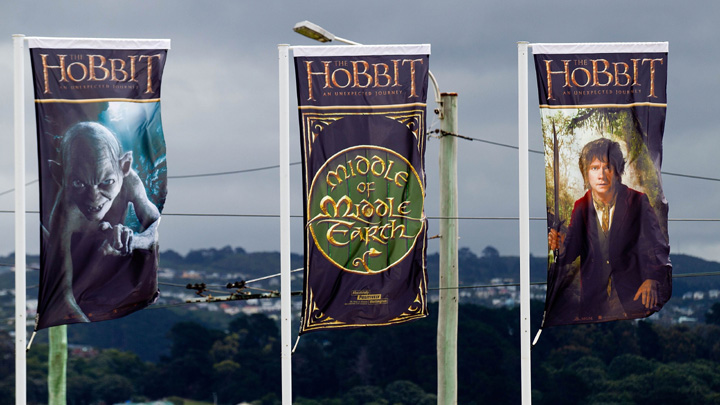Middle Earth mania for Hobbit debut

his picture taken on November 24th, 2012 shows flags advertising “The Hobbit” movie fluttering at Wellington airport in Wellington. AFP / MARTY MELVILLE
WELLINGTON – Huge crowds swarmed into central Wellington on Wednesday for the world premiere of Peter Jackson’s “The Hobbit”, an event that has sparked Middle Earth mania in New Zealand.
Presenters on national radio greeted listeners in the fictional language elvish on Wednesday morning, while newspapers came with complimentary Hobbit posters, and sculptures of characters from the film dotted the capital.
Hundreds of fans, many in costume, staked out spots hoping for a glimpse of stars such as Cate Blanchett, Elijah Wood and Martin Freeman treading a 500-metre (550-yard) red carpet leading to the Embassy Theatre.
“It’s going to be magical,” said Mia Ramsden, who travelled from Melbourne, Australia, for the premiere and camped overnight dressed as the elf queen Arwen to claim a prime position to view the stars.
Wellington has renamed itself “The Middle of Middle Earth” for the event and the New Zealand tourism industry has launched a major promotional push on the back of the movies, hoping to revive flagging international visitor numbers.
Article continues after this advertisementJackson admitted he was nervous about the reception his three-part prequel to the blockbuster “The Lord of the Rings” trilogy would receive, saying he had “lost all objectivity” during a lengthy and gruelling shoot.
Article continues after this advertisement“Nothing’s ever perfect and it never will be, it’s a real mistake if you say we’re stopping now because we’ve made the perfect film,” he told Radio New Zealand. “You never have and you never will.”
He added that he was making changes to the film until the last minute.
“I’ve got severe fatigue right now, but only because I’ve just finished the film,” he told reporters. “There’s been all sorts of obstacles.”
The films, which were shot back-to-back in New Zealand with an estimated budget of US$500 million, depict Bilbo’s quest to reclaim the lost dwarf kingdom of Erebor from the fearsome dragon Smaug.
Bringing the trilogy to the screen proved a saga in itself, taking more than six years since the project was first mooted in September 2006.
Mexican film-maker Guillermo del Toro was initially poised to direct, but quit in 2010 after years of delays due to legal wrangling between Hollywood studios over the rights to the book, forcing Jackson to take over.
When a green light to begin shooting was finally obtained, a union dispute threatened to move the production offshore — robbing it of its sweeping New Zealand backdrops — until the government intervened by changing labour laws.
Jackson was also struck down by ill health and last week there were allegations — strongly denied by producers — of animal cruelty and a US lawsuit filed by Tolkien’s heirs over marketing rights.
Critics have also questioned if a three-part saga is necessary, given the original book is barely 300 pages long, suggesting box-office returns — US$2.9 billion for the “Rings” trilogy — may have trumped artistic considerations.
There were no such reservations from Tolkien fan Theresa Collins, who was confident Jackson could repeat the success of his first Tolkien epic, which won 17 Oscars to become one of the most successful franchises in movie history.
“I think it’s going to be different, not as dark (as “Lord of the Rings”),” she told AFP. “It will still have that fan base from Lord of the Rings and will probably build on that.”
The first movie “The Hobbit: An Unexpected Journey” will be released globally in December.
The second, “The Hobbit: The Desolation of Smaug”, is due in December 2013 and the final chapter “The Hobbit: There and Back Again” follows in July 2014.